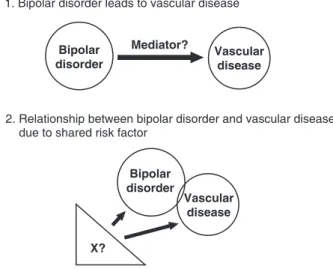LETTERS TO THE EDITOR
The search for mediators of
vascular mortality with
mania
Rev Bras Psiquiatr. 2014;36:98––99 doi:10.1590/1516-4446-2013-3505
In a recent issue of Revista Brasileira de Psiquiatria, Chiarani et al. reported a unique investigation to identify hypothesized state or trait biomarkers for cardiovascular risk in bipolar disorder.1 Large, epidemiological studies have consistently found an increased risk of cardiovas-cular mortality in bipolar disorder, approximately twice that expected on the basis of age and gender.2This risk is higher in bipolar I disorder, which conveys a greater burden of manic and hypomanic symptomatology, than in bipolar II disorder.3 The time course by which vasculo-pathy develops in bipolar disorder is unclear, although cross-sectional data suggest the excess risk is acquired over the long-term course of illness in those with a more persistent symptomatology.4 Cardiovascular mortality and endothelial dysfunction are related to manic symptom burden in a dose-dependent fashion, as demonstrated in a well-characterized prospective cohort,3,5 though spe-cific mediators that may explain this apparent state-related risk remain elusive.
To identify state-related differences in potential media-tors, Chiarani et al. followed individuals with mania to a period of euthymia, and utilized a separate control group to identify trait differences.1 No biomarkers associated with cardiovascular risk were associated with mania, apart from reductions in ferritin, an acute phase reactant. It is not clear how to interpret this finding. If not a false positive finding or the result of historical/instrument bias, it could reflect differences in diet, though low ferritin seems unlikely to explain any state-dependent effects on vascular disease risk.
Assuming the relationship between mania and vascular disease is temporal and cannot be entirely explained by confounding or adverse effects of treatments, there are a few explanations for the generally negative findings in the Chiarani et al.1 study: type II error, a non-causal relationship between mania and vascular disease, or the causal pathway for mania-related risk involves other mediators (Figure 1). One potential non-causal explana-tion involves shared genetic risk: that is, some genes which predispose an individual to mania may also convey risk for vascular disease. The brain, heart, blood vessels, and pancreatic islets of Langerhans all contain excitable cells, and any genetic abnormalities that impair function of excitable cells could increase the risk of neuropsychia-tric conditions, vascular disease, and diabetes mellitus. Additionally, there are several biologically plausible mechanisms by which disturbances of mood could induce physiological or behavioral changes that impact vascular
disease risk. Putative physiological changes include, but are not limited to, autonomic nervous system dysfunction, dysregulation of the hypothalamic-pituitary-adrenal axis, oxidative stress, and pro-inflammatory cytokines. Behavioral influences may involve adherence to treat-ment, diet, physical activity, and tobacco or other drug use.
Although cases of late onset or post-stroke mania may challenge this rule, bipolar disorder can generally be considered to precede vascular disease. Barring con-founding, this temporal relationship could be explained by a causal pathway leading from bipolar disorder to vascular disease, mediated by unknown variables pre-sumably influenced by mood state. As shown in Figure 1, a non-causal relationship between bipolar disorder and vascular disease could also demonstrate temporality through a shared risk factor with causal pathways of varying durations for lag times from exposure to outcome. Future research to investigate the most relevant mechanisms by which bipolar disorder and mood states may impact cardiovascular risk is required. The study design used by Chiarani et al.1may serve as a template to survey state- and trait-dependent variables which may mediate risk of vascular disease. It is further important to mind the authors’ concluding message: integrated med-ical and psychiatric care is needed to clinmed-ically address the medical comorbidities frequently present in those with bipolar disorder.
Jess G. Fiedorowicz,1,2,3Jonathan Linder,1,4 Simrit K. Sodhi1
1Department of Psychiatry, Roy J. and Lucille A. Carver College of
Medicine, University of Iowa, Iowa City, IA, USA.2Department of
Internal Medicine, Roy J. and Lucille A. Carver College of Medicine, University of Iowa, Iowa City, IA, USA.3Department of Epidemiology, College of Public Health, University of Iowa, Iowa City, IA, USA.4College of Pharmacy, University of Iowa, Iowa City,
IA, USA
Submitted Jan 08 2013, accepted Mar 06 2013.
Figure 1 Causal pathways to explain the relationship between bipolar disorder and vascular disease
Revista Brasileira de Psiquiatria. 2014;36
Acknowledgements
JGF is supported by the National Institute of Mental Health of the United States Department of Health and Human Services (1K23MH083695-01A210) and by the Institute for Clinical and Translational Science at the University of Iowa (3 UL1 RR024979-03S4).
Disclosure
The authors report no conflicts of interest.
References
1 Chiarani F, Tramontina JF, Cerese´r KM, Kunz M, Paim L, Vargas CR, et al. Homocysteine and other markers of cardiovascular risk during a manic episode in patients with bipolar disorder. Rev Bras Psiquiatr. 2013;35:157-60.
2 Weiner M, Warren L, Fiedorowicz JG. Cardiovascular morbidity and mortality in bipolar disorder. Ann Clin Psychiatry. 2011;23:40-7. 3 Fiedorowicz JG, Solomon DA, Endicott J, Leon AC, Li C, Rice JP,
et al. Manic/hypomanic symptom burden and cardiovascular mortality in bipolar disorder. Psychosom Med. 2009;71:598-606. 4 Sodhi SK, Linder J, Chenard CA, Miller del D, Haynes WG,
Fiedorowicz JG. Evidence for accelerated vascular aging in bipolar disorder. J Psychosom Res. 2012;73:175-9.
5 Fiedorowicz JG, Coryell WH, Rice JP, Warren LL, Haynes WG. Vasculopathy related to manic/hypomanic symptom burden and first-generation antipsychotics in a sub-sample from the colla-borative depression study. Psychother Psychosom. 2012;81: 235-43.
Letters to the Editor 99
